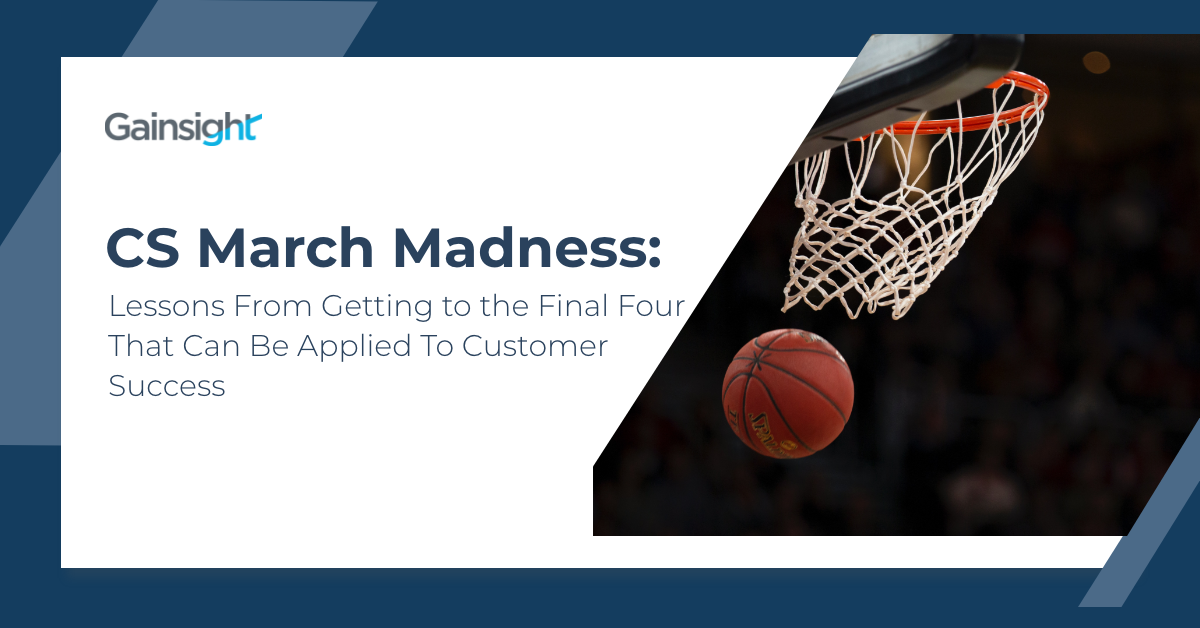As spring approaches, anticipation builds for a special event—March Madness! The time of year where brackets are drawn, team placement or seeds picked, and 68 Division I basketball teams fight it out in the single-elimination tournament. Sweat, blood, cheers, and tears lead teams to the Final Four and the NCAA National Basketball Championship.
There are “Blue Bloods” teams with long pedigrees and histories of repeated returns to the tourney. But even those teams can be off their game. The health of the season, less than adequate play, and last-minute injuries can turn early-season wins into late-season losses. What is exciting are the opportunities for “Cinderella” teams who make it to the big dance. These are the scrappy start-ups no one expected to make it but somehow broke through to the Final Four. And when teams get to elite levels of play, they don’t plan to lose. They step on the court expecting to win it all!
Winning Begins at the Top
You may wonder what does college basketball and customer success have in common. Well, a lot! There’s a whole organization generating opportunity for the team on the court. Many think success starts at the team level. They would be wrong. You can have the best players, but without strong leadership and guidance, they will go nowhere. That is why success begins at the top.
Your coach, or in this case a Chief Customer Officer or VP of Customer Success, must have a vision, plan, and direction. Next are the people surrounding you. Coaches need assistants, scouts, and players with buy-in and excitement for the game. As CCO, your team may be Professional Services, Education and Training, Field and Managed Services, CS, and Support. But they must have the same excitement and buy-in. CCOs want the board and executives to see their team’s impact on company success. Without data, there’s a lack of proof that what you are doing works. There’s not just adoption and user analytics. There’s also sentiment and health scores demonstrating customer experience leads to customer success.
As a CS leader, you must be willing to not only do what works but try new and cutting-edge motions. Successful basketball teams are built on and off the court with plans, playbooks, exercise, execution, and, yes, technology. Coaches and CS leaders are leaning more into technology than ever before. In basketball, tech uses include in-game films, replay systems during games, shot clocks or timers, and now shoes with sensors measuring a player’s attributes and motions. In CS, technology is changing the game, and you need to keep up. You want a platform to give you visibility into every part of your organization and your customers. Also, consider if it integrates with other functions and tools. Can different departments access it, and is it a central source of truth for all accounts? If not, you want Gainsight on your team.
The Basics
The beloved 10 times NCAA men’s basketball champion coach, John Wooden, once said, “I believe in the basics: attention to, and perfection of, tiny details that might be commonly overlooked. They may seem trivial, perhaps even laughable to those who don’t understand, but they aren’t. They are fundamental to your progress in basketball, business, and life.” Every CS organization must begin with the fundamentals. At Gainsight, we use a “crawl, walk, run” model describing the levels of how and when technology should be implemented and used. When you are in the crawl phase, the fundamentals can’t be overlooked.
No matter the size, most companies start in a crawl phase when they discover spreadsheets don’t cut it anymore. Customer information is not always visible, and neither are the problems putting customers at risk. Your goal may be recurring services revenue, but it’s hard to drive adoption, renewals, and expansion without the information or the right data on customers. Just as coaches review game films and keep statistics on their players and other teams, CS leaders need the same. They condition their CSMs for stamina and response. They create opportunities for communication amongst the team when someone is in trouble. They put the team in a position for success.
Gainsight PX is perfect for the crawl phase because it covers the basics. PX delivers an unequaled product experience with in-depth product analytics and personalized in-app engagements. Just as coaches know and understand their player’s capabilities on the court, you too can understand how your CSMs work, how users are interacting with your product, and proactively guide them both to value. Tracking the how and why of customer use can improve service rates, utilization, and margins while reducing time-to-value. Ultimately, PX helps deliver your customer’s outcomes. It also coaches CSMs not to miss valuable opportunities, drop the ball during passes in the lifecycle, or “foul out” in a customer relationship.
Beyond the Basics
For your teams, once they have the basics, they need to know more. Coaches conduct drills and run plays repeatedly until players know them instinctually and operate as a single unit. In CS, leaders make sure their CSMs have education, practices, and data to increase operational efficiency. This is the walk phase. With PX, you can remove administrative busywork to allow more customer contact. The more your team practices, improving efficiencies, you develop a healthy team. Being ‘on the ball’ as a player enables you to pass positive experiences to your customers who become healthier and show it in NPS scores recorded in PX. But PX is not your only option.
Learning different game styles can maximize your assets and improve your standing. That would be Gainsight CS. Your team learned plays. Now, they need the playbook. As a coach, you watched your players drill and scrimmage. You assess their skills and where they need help. You set strategic plays—planned movements to create open shots and score points. CS and PX let you discover which sequence of features and motions drive retention and growth. You get to see which plays to run and how long you have to guide users to realize your product’s value. In CS, you can visualize user activity with journey analysis and track each step to identify where users stop before finishing critical tasks within your product. Most of all, you can find adoption trends across customer segments and develop reports on users, accounts, and CRM data that create custom analytics.
CS consolidates data from multiple sources efficiently, giving a holistic understanding of your customer in a feature called 360. Just as multiple coaches and replay cameras on the court capture players’ moves, there are ways to design various layouts showing the right view depending on the customer’s attributes or the user’s role. And like replays and game films, CS lets you share a customer’s 360 View with stakeholders to drive greater alignment. But set plays aren’t enough to win the game. And in CS, more offerings can make your game better.
The Motion Offense
Once your team is “running,” the job isn’t over. In basketball, you face teams from larger universities with more resources to build out their program. But a good coach can pull the best out of players and change the plays to accommodate opponents. PX and CS together can do the same. Together they level the court and give you advantages over your competitors. For basketball, the best way is a Motion Offense. These are movements based on five key elements: hard cuts, passing, the screen, ball reversal, and shot selection.
In Motion Offense, all players frequently move, cutting between the opposition to be open for passes. This offense applies to CS. There’s no time for standing around. You need to be checking on your customers and injecting yourself into the relationship like a player inserts themselves into opposing play. With CS, you must monitor your customer’s progress, communicate with them in various formats, and use Timelines to see who has been talking to them from your company. Timeline provides a central location for the entire account team to input notes, updates, and information for everyone to see. It also has easy dynamic access for searching and reporting, preventing siloed information.
Lack of data and visibility and control over the user experience is always a concern. In basketball, screens are used by fellow teammates to solve a blocked player and get them open to make the play. In Gainsight CS we solve this issue with Playbooks. Playbooks are prescriptive motions and calls to action to know what to do when a customer is at risk. It helps automate responses with AI-priority scoring. If a customer is in trouble, you know which play to run to open them up for an opportunity for recovery.
One of the best things a player can do is cause a ball reversal. Now, that may sound like churn but in actuality, it is churn prevention. Anytime you can turn the action on the court around in your favor, you are doing a good thing by looking for opportunities and mistakes. In CS, that is your Dashboards and Reporting. They help you better decide with insight into your customer portfolio and analyze trends across your customer segments. Like a player watching the opposition on the court, you can look for opportunities by creating multiple customer dashboards to surface the right insight at the right time and leverage the information for a pivot. Just like a player calling out plays or signals, you can share dashboards as a webpage for easy access outside of the Gainsight UI for key stakeholders to see.
When players have been taught the plays and they have the visibility of positions of the other players, they are more likely to take open, calculated, and created shots, rather than sloppy balls thrown up hoping to score. PX and CS create the same opportunities. With increased adoption and understanding of what customers are doing and how they are using your product, you know their health standing. Devising health scores with PX Scorecards are one tool that helps. So does CS Success Plans. It captures, delivers, and demonstrates your customer outcomes. You can organize team activities to collaborate directly with customer stakeholders moving them to their desired outcomes. Your team can execute on objectives and tasks producing results. Looking for opportunities? Seeing who’s open to a pass? Calculate shots on the court translate into expansions, upsells, and renewals.
Competing Against Yourself
Basketball is a fast-paced and exciting game but so is CS. When everyone is on the same page of the playbook, playing to the best of their abilities, using every tool to enable their play, it can be a beautiful thing to behold. But in CS, you aren’t competing against opponents as much as you are competing against yourselves. Are you bringing our ‘A’ game every day? Are you building on and refining the basics? Are you taking every opportunity to relate data and connect with customers for expansions and renewals?
CS and PX creates a positive offense. You see the entire court and it enables you to scale programs across a large set of diverse customers. Lacking data is no longer a problem. The information gathered through data analysis lets you to understand the impact your team has on revenue and profit. It justifies to your executive team and board funding CS is worth it. CS and PX give you greater control over the customer experience. It also prevents churn which puts you at the bottom of the standings and a greater likelihood of you maintaining and improving your status. In basketball, team rankings can affect your end of season placement. In CS, customer health scores determine renewals and churn. So, put your team on the court with no doubts by combining PX and CS as your ultimate winning strategy.

